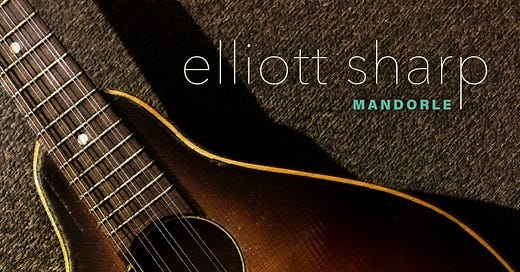The roots of the modern mandolin as well as its name lie in the lutes barbut, oud and pandura,brought to Iberia by the Moors in the 7th Century CE, all instruments of an almond shape, the mandorle. My introduction to the joys of the mandolin came during high school from my buddy Joel Eckhaus, now the esteemed luthier of Earnest Instruments and mandolinist emeritus of the Arm And Hammer String Band. In those days I might listen avidly to Frank Wakefield, Tiny Moore, Yank Rachell, or the Louvin Brothers but didn't take my first steps as a mandolinist until much later.
On tour in Europe in May 1983, I found a new Cremona flattop mandolina for the equivalent of $17 in a department store in Prague, Czechoslovakia. The Cremona instruments were made at the Strunal factory in Luba and were of notoriously low-quality but with a little work could be made quite playable with a punchy, slightly brittle sound and lending itself well to the piece Sound Czech. In 1984 while traveling throughout Mexico, a few days were spent in Merida in the Yucatan state. I hadn't brought an instrument with me and was jonesing for the haptic and psychic pleasures of noodling. In the zocalo I came upon a young Mayan sitting on a rug festooned with a variety of household items for sale including a mandolin built on the body of an armadillo. My Spanish was rudimentary as was that of the Mayan but through sign language he indicated to me that the armadillo (which he called wex - pronounced 'wetch') had been very tasty. The action was too high for normal playing but I could plunk on it or play slide with a small glass bottle and thereby preserve my sanity. I've played it using wire mallets on the soundtrack to What Sebastian Dreamt as well as on this album's Yucateca.
While walking around Budapest during a day off on tour in 1985, I spotted an obviously aged A-style mandolin in the window of a doll repair business. I purchased it for $23 and am continually delighted by its sound. It's been used on albums by Mofungo and Terraplane and here on Awake In The Field (for Frank Wakefield). Also in the Studio zOaR mandolin arsenal are a 1950s Framus Nevada mandolinetto (a mandolin with a guitar-shaped body) quite similar to Ira Louvin's Framus Graziella and an F-style mandolin built from a kit. The mandolinetto was played on The Devil Is Real (for Ira Louvin) and Room 109 (for Alvin Lucier) dedicated to the visionary composer Alvin Lucier and his explorations of the transient and resonance. The F-mandolin was used for the other pieces, musings on favored themes including the Fibonacci series, fractal geometry, and wave phenomena.
Of the electric pieces, the first, Sri Vast, was played on a 1990s Fender electric 5-string. During the 1980s, Manhattan's Little India in the East 20s boasted a number of groceries specializing in spices but also renting out VHS tapes of Bollywood films and selling cassettes of Indian classical music andfilmi soundtracks. On one of my forays there around 1987, I came across a cassette titled Mandolin Ecstasy by U Srinivas with the cover showing a young man with an electric mandolin. My ears and mind were blown by the virtuosic Carnatic music played by Srinivas and I became a devoted fan and found seeing him in concert even more inspiring than the recordings. Though I've never formally studied Carnatic or Hindustani music, through close listening for over 50 years and careful study of the techniques of ornamenting melody with slides and bends, in this track I offer a tribute. The Ebow (an electronic bow) was used with a mandocello to generate the the tamboura-like drones. Ebow was also used to create the acoustic feedback sounds on Paraphasia . Finally, the last two pieces were played on a 1960s Japanese-made Kingston electric mandola (tuned a fifth lower than the mandolin) processed using the Eventide H90.
credits
released November 1, 2024
Recorded, mixed, and mastered at Studio zOaR - NYC, July 2024
The acoustic pieces were recorded using Neumann TLM170 and EV RE20 microphones with Focusrite and Sytek preamps while the electric pieces were recorded direct into Pro Tools.
Elliott Sharp: composer, multi-instrumentalist, producer, author, leads Orchestra Carbon, Tectonics and Terraplane with compositional strategies including fractal geometry, chaos theory, and genetic metaphors as well as new techniques for graphic notation to yield work that catalyzes a synesthetic approach to musicmaking as well as functioning as retinal art.





